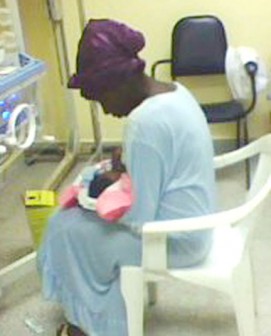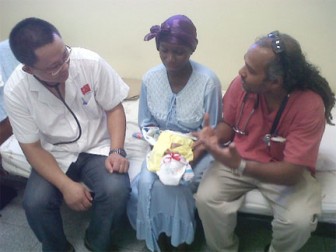Staff at the Linden Hospital Complex (LHC) who recently exhibited determination, commitment and a desire for a positive image were rewarded by being able to sustain a twenty-three-week-old foetus.
And baby Faith Renika Newyear also seemed determined to live, bringing much joy into the lives of her mother Renika Newyear and two brothers, ages seven and eleven years.
Her mother got a shock of her life while urinating when she experienced some pains and suddenly felt the baby coming and before she knew it the infant fell to the concrete floor.

The baby was alive but was only twenty-three-weeks old. Her mother-in-law was confused just as much as she was surprised. “I called out to my mother-in-law because it was just the two of us and told her to call the neighbour who came and picked the baby up, wrap her and rushed me to the Wismar Hospital,” said the woman.
All the while baby Faith was alive, breathing and intermittently crying but her prognosis was not too promising when she arrived at the hospital.
“The nurses examined me and said that they were feeling another baby,” recollected her mother. The nurses at the Upper Demerara Hospital (Wismar Hospital) spared no time in transferring mother and child to the Linden Hospital Complex where they could access better care.
Under normal conditions the ambulance would take approximately ten minutes from the UDH to the LHC at emergency pace, but the ride according to the mother seemed “like forever”.
And she had two issues plaguing her, the news that there might be a second child in her uterus and the prognosis of her newborn pre-term baby.

However, when they arrived at the LHC, General Medical Practitioner Dr. Steve Marks, Chief Medical Officer Dr. Farouk Riyasat and a team of nurses rose to the challenge.
“When baby came she had a Apgar score of two which is very low, baby had respiratory distress like flaring and retract, and when we did the calculation the baby was twenty-seven weeks, four days. At that stage the lungs ain’t even start to mature but she had good prognostic signs that she can make it,” noted Dr. Marks.
The Apgar score, developed by anesthesiologist Virginia Apgar in 1952 and now used in modern hospitals worldwide, rates a baby’s appearance, pulse, responsiveness, muscle activity, and breathing with a number between zero and 2 (2 being the strongest rating). The numbers are totalled, and 10 is considered a perfect score.
The mother was rushed to the operating theatre where she was re-examined by Dr. Riyasat who discovered that there was not a second child but rather the placenta/afterbirth that was still in the woman and the medical team took steps to remove it.
Dr. Marks said that they were determined to save the life of the infant because as a hospital they placed high value on every life.
“Over the years to the people and even the media sometimes, the hospital is not doing enough, it’s not doing well, we like a big health centre, so we took a stand that we must fight very hard to portray a positive image. When there is a positive development we’ll highlight it, when there is a negative we know it will be out there too,” said Dr. Marks.
Veins
For a few days Dr. Marks and the team did the routine things like giving the baby intravenous (IV) fluids and sometimes this was challenging because the veins were very tiny. They supplied oxygen and warmth and the baby kept showing good signs.
After three days baby Faith was introduced to small amounts of feed because the sucking reflex was present. “Bear in mind during this period I wasn’t alone, consultation was being done with my senior colleagues in Georgetown for advice because I think that was important.” He noted that paediatrician Gu was on vacation at the time.
The feeding process was also a success as there were no regurgitations. Things took a twist one week after as the baby’s weight made a sudden drop.
“But this was expected in the first week, but baby was looking a kind of pale so we decided to do a blood test but it was so difficult for the lab to get blood so we had to go femoral. The result the HB was 6.7 which is low, so we had a compounded problem, now we had to get blood.” Her birth weight was 1.4 kg.
Acquiring blood bags and other necessary supplies which the department had requested more than six months ago were the challenges in addition of the uncertainty of finding a vein.
“I spoke with Dr. Riyasat and told him that baby was not doing well and if we don’t get the blood bag…” It took the initiative of having a layman source the bag in Georgetown and taking it to the LHC so the medical team could transfuse baby Faith.
“The hospital couldn’t get me the bag so I get somebody from the road to go and get me deh bag and that was how we saved the day,” Dr. Marks recalled.
It took what is called a surgical cut-down to facilitate the transfusion since finding a vein was proving difficult. This worked for a short while and stopped. In the meantime the blood was getting close to expiration time. Another doctor was called in to assist. According to Dr. Marks, Dr. Steven came to the rescue resulting in them finding a line to transfuse the blood. During the long hours of transfusion one doctor stood holding the hand while the other held the blood bag while elevated to ensure a successful transfusion.
The hard work paid dividends. After three days Faith’s HB was over 10, her sucking reflex improved causing her to feed more by pulling from the breast while her muscles got stronger and then there was evidence of weight gain.
“At week two she was up to full breast feeding, full,” said a cheerful Dr. Marks. Faith was then introduced to the normal environment being weaned from the incubator, initially for two hours at a time.
Soon Faith and her mother were transferred to the paediatric ward in a private room where they stayed until being discharged with a weight of 2.5 kg.
The LHC had come under fire frequently especially in the area of neonatology and paediatric care to some extent because of the high rate of transfers from the LHC to the GPHC.
“During the period from January we used to have like five, six, seven patients being transferred to Georgetown, sometimes three in one week. So when I came back we embarked on a teaching/training programme to improve the level of our health care delivery and now it’s paying off.”
Prior to achieving the recent success when the LHC was able to save the life of baby Faith, they took care of a mother with twins from the gestational age of thirty-three weeks after they were delivered at the local facility at a very low birth rate and were nursed to full health by the Linden team of medical professionals.
Neonatal Unit
Dr. Marks emphasized the need for neonatal training for himself and nurses attached to the LHC. He said that if the hospital is to perform to its best ongoing training is necessary for the entire staff, especially nurses and doctors. He also underscored the importance of the facility being outfitted with a neonatal unit as opposed to the present nursery.
“The nursery got some stuff but we still need a lot of things to make it really effective. Since I came I have been asking for blood bags, small blood bags and many other things, so training is important, equipment is important. This is just one thing we did without nothing and if we get more we can be a whole lot more effective.”
Nurses have constantly expressed concern that they have not been afforded the opportunity of attending specialized training programmes as their colleagues in other parts of the country.
Dr. Marks attested to the fact that he has never been exposed to a post-graduate training since being at the LHC.
“The nurses are crying out, they are saying that you want to give me this small baby, then I need the training so I can do the right thing with the right knowledge.”
Over the past three months the paediatric department has had only three transferrals to Georgetown and this is seen as a great improvement and according to Dr. Marks the hospital’s administration would have saved a significant amount of revenue which should be put into training for its medical staff.
“Since I came here we haven’t lost one child, not one on the ward, I don’t know of the record of what transpired before.” He also said that several other departments have been making significant strides in the area of healthcare delivery.




